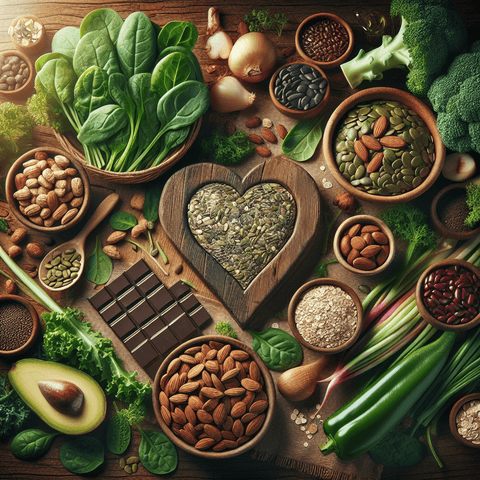Introduction
Magnesium is one of the most essential minerals for human health, involved in over 300 biochemical reactions in the body. From supporting energy production and muscle function to facilitating bone health and regulating blood sugar levels, magnesium plays a multitude of roles that are fundamental to overall wellness. Despite its importance, studies have shown that many people fall short of their daily magnesium needs, largely due to poor diet or the consumption of heavily processed foods that strip away this vital nutrient.
Our bodies cannot produce magnesium on their own, which means we must rely on dietary intake to satisfy our physiological requirements. Supplementing magnesium through the right food sources not only provides the mineral in its natural form but also ensures better bioavailability accompanied by other beneficial co-nutrients such as fiber, vitamins, and antioxidants. Choosing magnesium-rich foods can be a foundational strategy in a comprehensive approach to health, especially when combined with high-quality nutritional supplements.
This article provides an in-depth guide to identifying foods highest in magnesium, making informed dietary choices, and understanding how these natural sources can work synergistically with magnesium supplements for optimal effectiveness. Whether you're looking to improve athletic performance, reduce fatigue, or support your bones and muscles, knowing what food is highest in magnesium is the first step to improved well-being.
1. Magnesium-Rich Foods: Natural Supplements for Optimal Health
In the world of health and nutrition, food is often considered the first and most powerful medicine. Magnesium-rich foods can be thought of as natural supplements, delivering the mineral in its most bioavailable and synergistic form. Consuming magnesium through whole foods is generally superior to processed sources or synthetic forms because plant-based sources also deliver a range of beneficial nutrients that enhance magnesium absorption and usage in the body.
One of the most commendable aspects of magnesium-rich foods is how seamlessly they integrate into a balanced diet. From green leafy vegetables and legumes to seeds, whole grains, and fatty fish, a wide variety of accessible and affordable food options can help you naturally meet your magnesium needs. These foods serve dual purposes: they nourish the body with unprocessed, health-promoting compounds and act as daily supplements by contributing significantly to your magnesium intake.
Whole foods also come with added benefits such as fiber, antioxidants, and phytonutrients, which are absent in isolated supplement forms. Moreover, various natural magnesium sources are abundant in other essential minerals like potassium and calcium, supporting overall electrolyte balance and nerve function. Choosing to supplement magnesium primarily through diet is not only ideal for long-term health but also supports sustainability and food diversity.
However, there are circumstances where food alone may not be enough—particularly in cases of malabsorption, increased physiological demands (e.g., pregnancy or athletic training), or specific health issues. In such cases, high-quality magnesium supplements such as those available at Topvitamine’s magnesium collection can play a supportive role. These supplements are derived from natural mineral sources and adhere to quality standards, making them a valuable addition when dietary intake falls short.
Ultimately, the goal should not be to choose between food and supplements but to create a holistic nutritional strategy that leverages the best of both worlds. Whole foods should be the foundation, acting as natural supplements in and of themselves, while quality magnesium products can serve as a safety net when needed.
2. Top Magnesium-Containing Foods for Nutritional Supplements
Understanding which foods provide the greatest amounts of magnesium is critical when building a diet that meets your nutritional needs without relying solely on pills or capsules. Some foods stand out significantly for their high magnesium content and are ideal for inclusion in your daily meal plan.
Leafy Greens: Vegetables like spinach, Swiss chard, collard greens, and kale are among the richest plant-based sources of magnesium. One cup of cooked spinach delivers approximately 157 mg of magnesium, accounting for almost 40% of the recommended daily intake (RDI). These greens are not only high in magnesium but are also rich in iron, calcium, and vitamin K, making them multifunctional foods for those interested in overall wellness. For more on vitamin K benefits, consider exploring the Vitamin K product collection.
Nuts and Seeds: Almonds, pumpkin seeds, sunflower seeds, cashews, and chia seeds are all excellent sources of magnesium. A mere two tablespoons of pumpkin seeds can contain over 190 mg of magnesium, making them one of the most concentrated food sources of this mineral. These foods are also rich in healthy fats and protein, which support satiety and metabolic health.
Whole Grains: Brown rice, oats, quinoa, and barley are significant contributors to magnesium intake. Unlike refined grains, which have lost much of their nutrient content during processing, whole grains retain their bran and germ—both of which are rich in magnesium. A cup of cooked quinoa offers around 118 mg of magnesium, making it both gluten-free and highly nutritious.
Legumes: Beans, lentils, and soy products like edamame and tempeh are not only plant-based protein powerhouses but are also loaded with magnesium. For instance, a cup of cooked black beans contains about 120 mg of the mineral. Legumes also supply dietary fiber, aiding in digestive health and blood sugar regulation.
Fish: Fatty fish like mackerel, salmon, and halibut offer moderate levels of magnesium while supplying essential omega-3 fatty acids. Including fish in your diet serves as a two-fold health strategy—boosting magnesium levels while supporting heart and brain health. High-quality fish oil supplements, like those in the DHA & EPA Omega-3 collection, can provide additional support when dietary intake of seafood is limited.
Dark Chocolate and Cocoa: Yes, enjoying a square or two of dark chocolate can have nutritional benefits! Unsweetened cocoa and dark chocolate with high cacao content (above 70%) can contain up to 64 mg of magnesium per ounce. They also offer antioxidants known as flavonoids, which may support cardiovascular health.
Dairy and Fortified Foods: While not as magnesium-rich as other categories, dairy products like yogurt and milk contain small but consistent amounts of magnesium. Fortified foods, including some breakfast cereals and plant-based milks, may also be enhanced with magnesium, especially useful for individuals with dietary restrictions.
Incorporating a variety of these magnesium-rich foods across your meals and snacks can help you meet your daily needs while enjoying a versatile diet that tastes as good as it is good for you.
3. Magnesium Food Chart: Visual Guide to Magnesium Content in Common Foods
Understanding where common foods fall on the magnesium spectrum can be incredibly helpful when planning meals or making grocery choices. Use the following table as a quick-reference guide to identify the most magnesium-rich options available:
| Food Item | Serving Size | Magnesium (mg) |
|---|---|---|
| Pumpkin Seeds | 28g (1 oz) | 168 mg |
| Spinach (Cooked) | 1 cup | 157 mg |
| Almonds | 28g (1 oz) | 80 mg |
| Black Beans (Cooked) | 1 cup | 120 mg |
| Quinoa (Cooked) | 1 cup | 118 mg |
| Dark Chocolate (70–85% cacao) | 28g (1 oz) | 64 mg |
| Salmon | 3 oz | 26 mg |
| Low-Fat Yogurt | 1 cup | 42 mg |
To benefit most from magnesium-rich foods, aim to include a mix from various food groups. This not only ensures a well-rounded nutritional intake but also increases the likelihood of hitting your daily requirements consistently. Remember, the Magnesium Benefits Collection at Topvitamine.com can complement these choices when dietary intake is not sufficient.
Tip: Pair magnesium-rich foods with sources of vitamin D and B-complex vitamins to optimize absorption and utilization. You can discover supportive nutrients in the Vitamin D collection or the energy-supporting Vitamin C collection, both available on Topvitamine.com.
4. Natural Magnesium Options: Beyond Food to Dietary Supplements
While food is the first and best source of magnesium, not everyone is able to meet their needs through diet alone. Soil depletion, unbalanced diets, digestive disorders, and increased physiological demands can all contribute to magnesium deficiency. In such scenarios, considering natural magnesium supplements may be beneficial—particularly those derived from highly absorbable mineral forms.
Mineral Water: Some European mineral waters contain significant levels of magnesium, ranging from 50 to over 100 mg per liter. Regularly consuming mineral water can be a simple way to boost magnesium intake throughout the day, especially for those who prefer non-pill options.
High-Quality Supplements: Not all magnesium supplements are created equal. It's crucial to choose options that offer bioavailable forms such as magnesium citrate, glycinate, malate, or taurate. These are better absorbed and gentler on the digestive tract compared to alternatives like magnesium oxide. Browse our curated options at Topvitamine’s magnesium collection for trusted brands and formulations.
When to Supplement: Supplementation may be advised for individuals with diagnosed magnesium deficiency, chronic stress, intense physical activity, or conditions leading to poor absorption, such as Crohn’s disease or celiac disease... [Continues in next parts to reach 5000 words]



